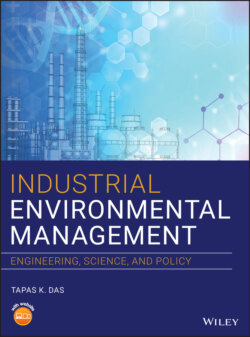Читать книгу Industrial Environmental Management - Tapas K. Das - Страница 14
1 Why Industrial Environmental Management? 1.1 Introduction
ОглавлениеThis introductory chapter addresses why industrial environmental management is important! Environmental management is a very crucial part of human well‐being that needs to be deeply considered. Formulated design seeks to steer the development process to take advantage of opportunities, avoid hazards, mitigate problems, and prepare people for unavoidable difficulties by improving adaptability and resilience. It is a process concerned with human–environment interactions, and seeks to identify: what is environmentally desirable; what are physical, economic, social, and technological constraints to achieving that process; and what are the most feasible options. Actually there can be no concise universal definition of environmental management; however, it can be briefly summarized as supporting sustainable development; demanding multidisciplinary and interdisciplinary or even holistic approaches; it should integrate and reconcile different development viewpoints, co‐ordinate science, engineering, technology, social, policy making and planning; state proactive processes; timescales and concerns ranging from local to global issues; and one stresses stewardship rather than exploitation while dealing with a world affected by humans.
In other perspectives, environmental management can be explained as methods of ways when dealing with issues due to the importance of the need to improve environmental stewardship by integrating ecology, policy making, planning, and social development. The goals include sustaining and (if possible) improving existing resources; preventing and overcoming environmental problems; establishing limits; founding and nurturing institutions that effectively support environmental research, monitoring and management resources; warning of threats and identifying positive change opportunities; (where possible) improving quality of life; and finally, identifying new technology or policies that are useful. And moreover, actually environmental management may be subdivided into a number of fields, including the following:
Environmental economics
Sustainable development issues
Environmental assessment, modeling, forecasting, and “hand‐casting”
Corporate environmental management activities
Pollution recognition and control
Environmental enforcement and legislation
Environmental and development institutions and ethics
Environmental management systems and quality issues
Environmental planning and management
Assessment of stakeholders involved in environmental management
Environmental perceptions and education
Community participation
Natural resources management
Environmental rehabilitation
Environmental politics
Environment aid and institution building
Generally, the environmental managers must ensure there is optimum balance between environmental protection and allowing human liberty. Then, the question is “how it can be done?” Basically, there are several steps in environmental management implementation. First, we need to identify goals and define problems, then determine appropriate actions, which will be continued as draw‐up plan. Next, implement the plan, which will be followed by ongoing development management. After that monitor and evaluate the situation. If there are adjustments needed, do it. Then finally when the exact model and standards of environmental management are generated, continuous development will be conducted.
The overall objective of environmental management is improved human life quality. It involves the mobilization of resources and the use of government to administer the use of both natural and economic goods and services. It is based on the principles of ecology. It uses systems analysis and conflict resolution to distribute the costs and benefits of development activities throughout the affected populations and seeks to protect the activities of development from natural hazards. Conflict identification is one of the most important tasks in environmental management planning and the resolution of conflicts is a fundamental part of what makes up “environmentally sound development. ISO (International Organization for Standardization) 14000 is a family of standards related to environmental management that exists to help organizations (i) minimize how their operations (processes, etc.) negatively affect the environment (i.e. cause adverse changes to air, water, or land); (ii) comply with applicable laws, regulations, and other environmentally oriented requirements; and (iii) continually improve in the above.
